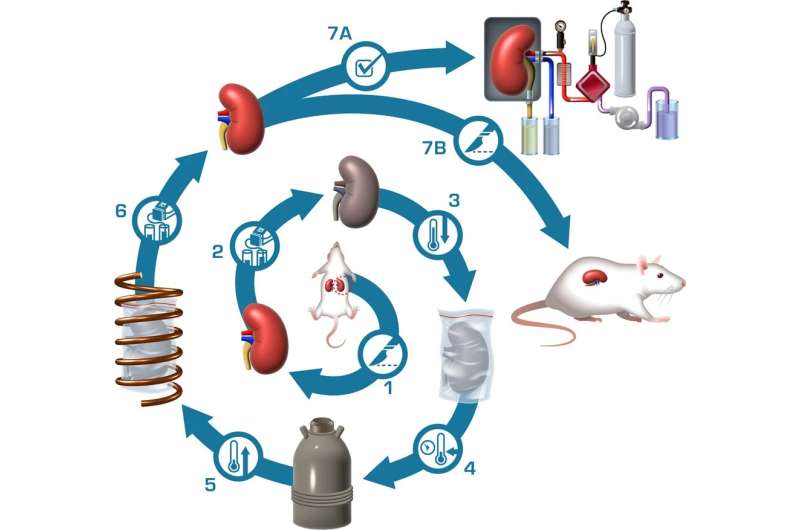June 26, 2023 report
This article has been reviewed according to Science X's editorial process and policies. Editors have highlighted the following attributes while ensuring the content's credibility:
fact-checked
peer-reviewed publication
trusted source
proofread
In a first for organ transplantation, cryogenically frozen rat kidneys still usable after 100 days

A team of cryo-engineers and surgeons at the University of Minnesota has found a way to cryogenically freeze and thaw rat organs in a way that preserves their viability. In their study, reported in the journal Nature Communications, the group overcame previous problems with freezing organs with their new procedure.
Medical scientists have sought to freeze and thaw human organs ever since organs were successfully removed from one person and transplanted into another—freezing would greatly expand the pool of available donated organs. The problem has always been the same—freezing organs leads to the formation of crystals that damage tissue and thawing them unevenly also results in damage. In this new effort, the research team in Minnesota has found a way to overcome both problems.
When tissue is frozen, ice crystals form between cells, resulting in damage. To overcome this problem, the researchers used a technique called snap-freezing, where cryoprotective chemicals were injected into the tissue which was then very quickly frozen. Instead of crystals, a glass-like material formed that did not cause damage. The team then turned their attention to the thawing process.
Most techniques for thawing tissue involve setting a sample at room temperature until it thaws, sometimes applying heat or even using microwaves. Unfortunately, each of these techniques suffer from the same problem: uneven thawing, where tissue warms at different rates in the same organ. This results in cracks or tears, rendering an organ useless. To overcome this problem, the team injected iron oxide particles into an organ before it was frozen. They then used alternating magnetic fields to warm the tissue to room temperature—each of the nanoparticles served as a tiny heater. The result was evenly thawed tissue.
To test their technique, the research team froze several rat kidneys and held them frozen for up to 100 days. They then thawed the organs, cleaned out the chemicals and nanoparticles and implanted five of them into live test rats. Testing showed that all the rats survived the procedure and that all of them regained full kidney function within 30 days of their transplant. More testing is required before similar testing can be done on humans, but the researchers suggest their work could significantly improve the chances of patients who need an organ receiving one before their time runs out.
More information: Zonghu Han et al, Vitrification and nanowarming enable long-term organ cryopreservation and life-sustaining kidney transplantation in a rat model, Nature Communications (2023). DOI: 10.1038/s41467-023-38824-8
© 2023 Science X Network




















